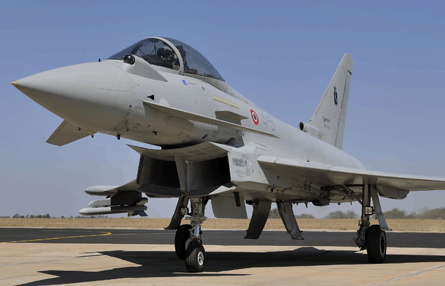Budgetary pressures being encountered by partner nations Germany, Italy, Spain and the UK have halted talks about the proposed Tranche 3B production phase of the Eurofighter programme, according to one of its key industrial participants.
"Currently, it's probably not a good time to engage in discussions between industry and governments on Tranche 3B, so we will see how this develops in due time," said Stefan Zoller, chief executive of EADS's Cassidian business unit.
"There is nothing on the agenda this year or next year," Zoller said during a financial presentation at Cassidian's Unterschleissheim headquarters near Munich on 28 March. "Our governments have no money," he added. "We have to see whether we can shift those discussions and firm commitments to a later date."
 |
|---|
© Eurofighter |
Noting that the decision is closely linked to the future export prospects of the Eurofighter Typhoon, Zoller said: "What we have to avoid is a break in the production line. We are in contact with the customers to see how we manage that."
One previously identified option could be to slow down the programme's current high production rate as a means of extending work beyond the expected completion of the last of 112 Tranche 3A aircraft in around 2015.
Formed of Alenia Aeronautica, BAE Systems and EADS, the Eurofighter industry consortium submitted its first offer for the proposed 124-aircraft Tranche 3B deal last May, with the goal of securing a contract signature by the end of 2011.
Its viability was quickly threatened, however, with both Italy and the UK stating their intention to end their purchases after Tranche 3A production. This would represent a failure by the nations to honour there four-nation commitment for 620 aircraft.
The UK has so far ordered 160 aircraft, but argues that its total planned offtake of 232 has already been met, after brokering the government-to-government sale of 72 Typhoons to Saudi Arabia.
Asked whether the lack of a firm commitment to Tranche 3B production could hurt the Typhoon's long-term export potential, Zoller noted Cassidian's steadily rising annual spend on self-funded research and development, which totalled €251 million ($354 million) last year.
"Now we see more defence customers having the idea to go 'off-the-shelf', with no pre-financing of R&D. We don't want to lose some competitive edge in our programmes, so we already started to finance on our own," he said. One such example is in developing an active electronically scanned array (AESA) radar for the Typhoon.
"E-scan for Eurofighter, which is a very decisive subject to stay in international competitions, is for the time being completely financed by industry. We have to keep the momentum and the technology developed, otherwise we shoot ourselves out of the market," he said.
The availability of an AESA sensor is now mandated in most fighter competitions, such as the Indian air force's 124-unit medium multirole combat aircraft battle. "Our customers have checked whether the capability is there or will be there in time for their aircraft," said Zoller. "We are in a very good position, and will have all the technology and all the features available."
The UK is funding a technology demonstration programme to integrate and fly an AESA radar with the Eurofighter, with Selex Galileo leading the effort. Noting that the required technology is already available in Europe, Zoller said: "The question is what is the British customer going to do, and how we align the [other] customers."
The Eurofighter programme dominates the current business activities of Cassidian Air Systems, which was itself responsible for around 40% of the company's €4.3 billion orderbook in 2010.
Source: Flight International



















